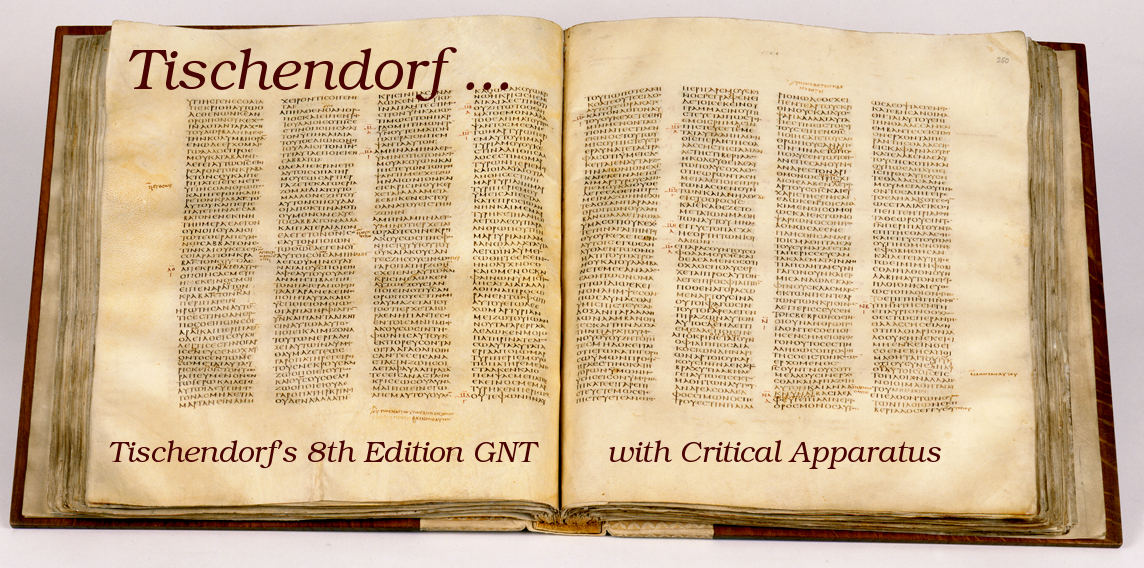APPENDIX A (K. Lake)
Tischendorf's NotationSome of these have been explained in the preceding chapters, but for general convenience these have been repeated here, together with all the others which are in general use.
The multiplication of these symbols is an ever-growing evil; and as no two writers seem to employ quite the same method, it is impossible to escape occasional misunderstandings. But since the basis of all other systems at the present day is that of Tischendorf, 8th ed., Greek NT, the necessary foundation of study is an acquaintance with his notation. The best way will be to take an example and go through its details.
Example: Matt. 6:44
In Mt 6,44. αγαπατε τους εχθρους υμων.
Tischendorf's note is:
T. εχθρ. υμων. c. א B 1 22 209 al4 a b ff1. g1. 2. k 1 vg sax fr cop syrcur Thphil3,14. Or 4,324.329.351. item 1,768. 4,353. Dial 20 Eusps 589 Ir int 210 Cyp ter al .....
ς (Gb00) add ευλογειτε τους καταρωμενους υμας (D , Athen om) c. DEKLMSU al pler c f h go syrsch etp arm aeth Athen legat11 Clem605 (omnino propter sqq e Mt vdtr) Euspraep 13,7 (omnino e Mt vdtr) Const1,2 Chr:: cf Lc |.
ς (Gb00) add ευλογειτε τους καταρωμενους υμας (D , Athen om) c. DEKLMSU al pler c f h go syrsch etp arm aeth Athen legat11 Clem605 (omnino propter sqq e Mt vdtr) Euspraep 13,7 (omnino e Mt vdtr) Const1,2 Chr:: cf Lc |.
..... implies that the list of authorities for the variant quoted has been exhausted, and that the alternatives will now be given. The | signifies the close of the whole passage under discussion. Had there been a third variant, there would have been some more after "cf Lc" instead of the |.
It appears, therefore, that in this passage there are two
(a) αγαπατε τους εχθρους υμων,Of these (a) is Tischendorf s reading, and therefore he first gives it and the authorities for it, introducing the latter with a c. (= "cum.", Latin for )
(b) αγαπατε τους εχθρους υμων, ευλογειτε τους καταρωμενους υμας.
Critical Editions (the TR etc.)
In these cases Tischendorf's practice is to indicate the reading of the editor or editors who differ from Stephanus by inserting a 'bracket' after ς, and using the following symbols : ςe - Elzevir, Sz - Schulz, Gb = Griesbach.
Subvariants in this notation are (e.g.):
(Gb 1) = "Griesbach thinks it probable"
(Gb 11) = "Griesbach thinks it very probable"
(Gb 0) = "Griesbach prefers the other variant"
(Gb 00) = "Griesbach strongly prefers the other variant"
(Gb 11) = "Griesbach thinks it very probable"
(Gb 0) = "Griesbach prefers the other variant"
(Gb 00) = "Griesbach strongly prefers the other variant"
MSS and Other Authorities
1. Greek uncials, quoted by capital letters.
2. Greek cursives, quoted by numbers as a rule.
3. The Latin authorities, with more important MSS listed.
4. Other versions.
5. Patristic quotations with references.
2. Greek cursives, quoted by numbers as a rule.
3. The Latin authorities, with more important MSS listed.
4. Other versions.
5. Patristic quotations with references.
- by the Old Latin MSS: a b ff1 g1 g2 k l, and (vg) = the Latin Vulgate.
The reading is also supported by the two secondary versions, sax. = the Anglo-Saxon, and fr.= the Frankish, both of which are derivatives of the Latin; by the cop. ( = Coptic version), now called the Bohairic; and by the Curetonian Syriac.
It is also supported by early writers, Theophylact, Origen, and an anonymous tract known as the 'Dialogus de recta fide' (Dial), by Eusebius in his Commentary on the Psalms (Eusps.), by the Latin translation of Irenaeus (Irenint = Irenaei interpres), by three quotations of the passage in Cyprian, and by others (al.).
In the case of each Father quoted the reference to the standard edition (usually the Benedictine) is given in small figures, e.g, Orig 4,324 = Origen, vol. 4 p. 324.
Alternate Variants
The secondary reading is also supported by Clement of Alexandria, Eusebius in his Praeparatio Evangelica, the 'Apostolic constitutions' (const.), and Chrysostom.
In the case of Clement & Eusebius, Tischendorf indicates in brackets (omnino e Mt vdtr) that there are reasons for believing that the quotation is from Mt (Matt.) not Lc (Luke), and the sign :: cf. Lc at the end means that he thinks that the reading is due to assimilation to the text of Luke.

Is there a website where we can access this apparatus directly?
ReplyDelete